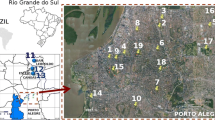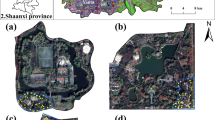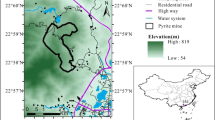Abstract
This study is focused on four Biobio region cities, Concepcion, Talcahuano, Los Ángeles, and Tomé; these cities flourished very close to different industrial activities. We determined a pseudo total concentration of seven heavy metals (Cr, Ni, Cu, Zn, As, Cd, and Pb) in playground soils through inductively coupled plasma-mass spectrometry (ICP-MS). Principal components analysis (PCA) revealed that contamination in soils comes from three principal sources. Firstly, industrial and burning activities; secondly, the use of phytosanitary and chemical products; and thirdly, vehicular traffic emissions. Zn and Cu are the most abundant analyzed elements in all the playground’s soils. Concepción reflected the lowest values of pollutants and Talcahuano the highest, reflecting the industrial effects. The average values of the analyzed elements were Cr = 32.90 mg kg−1; Ni = 23.76 mg kg−1; Cu = 31.51 mg kg−1; Zn = 63.69 mg kg−1; As = 19.51 mg kg−1; Cd = 0.50 mg kg−1; and Pb = 17.59 mg kg−1. Anomalously high values of some elements were found Cu = 462.73 mg kg−1, Zn = 364.39 mg kg−1, As = 34.7 mg kg−1 in Talcahuano, Cd = 1.6 mg kg−1 in Tome, and Pb = 55.59 mg kg−1 in Los Ángeles. Nevertheless, according to international guideline values of pollutants (VROM 2000 and ADEC 2010) there is no risk for children in any playground studied but all playgrounds are a potential risk for the environment. It points out the necessity to continue studying and monitoring Chilean urban playground to prevent health problems in the population.

Graphical abstract




Similar content being viewed by others
References
ADEC, Australian Department of Environment and Conservation (2010). Assessment level for soil, sediment and water. http://www.esdat.net/Environmental%20Standards/Australia/WA/Assessment%20Levels%20-%202010.pdf. Accessed June 2014.
Adriano, D.C. (1986). Trace elements in the terrestial environment. Springer-Verlan New York Inc. 533pp.
Aguilar, R., Hormazábal, C., Gaete, H., & Neaman, A. (2011). Spatial distribution of copper, organic matter and pH in agricultural soils affected by mining activities. Journal of Soil Science and Plant Nutrition, 11, 125–145.
Ajmone-Marsan, F., & Biasioli, M. (2010). Trace elements in soils of urban Áreas. Water, Air, and Soil Pollution, 213, 121–143.
Akinola, M.O., Njoku, K.L., & Ekeifo, B.E. (2008). Determination of lead, cadmium and chromium in the tissue of an economically important plant grown around a textile industry at Ibeshe, Ikorodu area of Lagos state, Nigeria. Advances in Environmental Biology.
Albanese, S., De Vivo, B., Lima, A., & Cicchella, D. (2007). Geochemical background and baseline values of toxic elements in stream sediments of Campania region (Italy). Journal of Geochemical Exploration, 93, 21–34.
Alloway, B. J. (1993). Heavy metals in soils. London: Blackie Academic and Professional.
Amorosi, A., Guermandi, M., Marchi, N., & Sammartino, I. (2014). Fingerprinting sedimentary and soil units by their natural metal contents: A new approach to assess metal contamination. Science of the Total Environment, 500-501, 361–372.
Baral, A., Engelken, R., Stephens, W., Farris, J., & Hannigan, R. (2006). Evaluation of aquatic toxicities of chromium and chromium-containing effluents in reference to chromium electroplating industries. Archives of Environmental Contamination and Toxicology, 50, 496–502.
Benedetti, M. F., Van Riemsdijk, W. H., Koopal, L. K., Kinniburgh, D. G., Gooddy, D. C., & Milne, C. J. (1996). Metal binding by natural organic matter: from the model to the field. Geochimica et Cosmochimica Acta, 60, 2503–2513.
Biney, C., Amuzu, A. T., Calamari, D., Kaba, N., Mbome, I. L., Naeve, H., Ochumba, P. B. O., Osibanjo, O., Radegonde, V., Saad, M. A. H. (1994). Review of Heavy Metals in the African Aquatic Environment. Ecotoxicology and Environmental Safety, 28(2), 134-159
Birke, M., & Rauch, U. (2000). Urban geochemistry: Investigations in the Berlin metropolitan area. Environmental Geochemistry and Health, 22, 233–248.
Buekers, J., De Brouwerea, K., Lefebvrea, W., Willemsa, H., Vandenbroeleb, M., Van Sprangb, P., Eliat-Eliatb, M., Hicksc, K., Schlekatd, C. E., & Ollerd, A. R. (2015). Assessment of human exposure to environmental sources of nickel in Europe: Inhalation exposure. Science of the Total Environment, 521–522, 359–371.
Bundschuh, J., Litter, M. I., Parvez, F., Román-Ross, G., Nicolli, H. B., Jean, J.-S., Liu, C.-W., López, D., Armienta, M. A., Guilherme, L. R. G., Gomez Cuevas, A., Cornejo, L., Cumbal, L., & Toujaguez, R. (2012). One century of arsenic exposure in Latin America: a review of history and occurrence from 14 countries. Science of the Total Environment, 429, 2–35.
Chen, T. B., Zheng, Y. M., Lei, M., Huang, Z. C., Wu, H. T., Chen, H., Fan, K. K., Yu, K., Wu, X., & Tian, Q. Z. (2005). Assessment of heavy metal pollution in surface soils of urban parks in Beijing, China. Chemosphere, 60(4), 542–551.
Cookson, L. J. (2008). Influence of CCA-treated pine structures on the arsenic content of soils in preschool playgrounds near Melbourne, Australia. Forest Products Journal, 58(11), 94.
De Gregori, I., Fuentes, E., Rojas, M., Pinochet, H., & Potin-Gautier, M. (2003). Monitoring of copper, arsenic and antimony levels in agricultural soils impacted and non-impacted by mining activities, from three regions in Chile. Journal of Environmental Monitoring (JEM), 5, 287–295.
De Miguel, E., Iribarren, I., Chacón, E., Ordoñez, A., & Charlesworth, S. (2007). Risk-based evaluation of the exposure of children to trace elements in playgrounds in Madrid (Spain). Chemosphere, 66, 505–513.
Díaz, M. E., Figueroa, R., Suárez Alonso, M. L., & Vidal-Abarca, M. R. (2018). Exploring the complex relations between water resources and social indicators: the Biobío Basin (Chile). Ecosystem Services, 31, 84–92.
FAO (Food agriculture Organization of the United Nations), IUSS (International Union of Soil Science), ISRIC (International Soil Reference and Information Centre) (2006). World Reference Base for Soil Resources, ISBN 92-5-105511-4. A framework for International Classification, Correlation and Communication, Rome, Italy.
Figueiredo, A. M. G., Tocchini, M., & dos Santos, T. F. S. (2011). Metals in playground soils of Sao Paulo city, Brazil. Procedia Environmental Sciences, 4, 303–309.
Ginocchio, R., Carvallo, G., Toro, I., Bustamante, E., Silva, Y., & Sepúlveda, N. (2004). Micro-spatial variation of soil metal pollution and plant recruitment near a copper smelter in Central Chile. Environmental Pollution, 127, 343–352. https://doi.org/10.1016/j.envpol.2003.08.020.
Gulson, B., Mizon, K., Tailor, A., Korsch, M., Stauber, L., Davis, L. M., Louie, H., Wu, M., & Swan, H. (2006). Changes in manganese and lead in the environment and young children associated with the introduction of methylcoclopentadienyl manganese tricarbonyl in gasoline-prelimuinary results. Environmental Research, 100, 100–114.
Guney, M., Zagury, G. J., Dogan, N., & Onay, T. T. (2010). Exposure assessment and risk characterization from trace elements following soil ingestion by children exposed to playgrounds, parks and picnic areas. Journal of Hazardous Materials, 182, 656–664.
Hong, S., Soyol-Erdene, T.-O., Hwang, H. J., Hong, S. B., Hur, S. D., & Motoyama, H. (2012). Evidence of global-scale As, Mo, Sb, and Tl atmospheric pollution in the Antarctic snow. |. Environmental Science & Technology, 46, 11550–11557.
Institute for Agricultural Research of Chile (Instituto de Investigaciones Agropecuarias) INIA (1990).
Kabata-Pendias, A. (1995). Trace elements in soils and plants. CRC Press, 3rd ed, p 331.
Kabata-Pendias, A. (2001). Trace elements in soil and plants (3rd ed.). Florida: CRC Press LLC.
Kabata-Pendias A. and Pendias, H. (1999). Biogeochemistry of Trace Elements, Polish Scientific Publishing Company, Varsov.
Kumpiene, J., Brännvall, E., Taraskevicius, R., Aksamitauskas, C., & Zinkute, R. (2011). Spatial variability of topsol contamination with trace elements in preschools in Vilnius, Lithuania. Journal of Geochemical Exploration, 108, 15–20.
Li, X. D., Poon, C., & Liu, P. S. (2001). Heavy metal contamination of urban soils and street dusts in Hong Kong. Applied Geochemistry, 16, 1361–1368.
Li, L., Holm, P. E., Marcussen, H., & Bruun Hansen, H. C. (2014). Release of cadmium, copper and lead from urban soils of Copenhagen. Environmental Pollution, 187, 90–97. https://doi.org/10.1016/j.envpol.2013.12.016.
Ljung, K., Selinus, O., Otabbong, E., Berglund, M. (2006a). Metal and arsenic distribution in soil particle sizes relevant to soil ingestion by children. Applied Geochemistry 21(9), 1613-1624.
Ljung, K., Selinus, O., Otabbonga, E. (2006b). Metals in soils of children's urban environments in the small northern European city of Uppsala. Science of The Total Environment, 366(2–3), 749-759.
Ljung, K., Oomen, A., Duits, M., Selinus, O., Berglund, M. (2007). Bioaccessibility of metals in urban playground soils. Journal of Environmental Science and Health, Part A 42(9), 1241-1250.
Lin, Y.-C., Tsai, C.-J., Wu, Y.-C., Zhang, R., Chi, K.-H., Huang, Y.-T., Lin, S.-H., & Hsu, S.-C. (2015). Characteristics of trace metals in traffic-derived particles in Hsuehshan Tunnel, Taiwan: size distribution, potential source, and fingerprinting metal ratio. Atmospheric Chemistry and Physics, 15, 4117–4130 www.atmos-chem-phys.net/15/4117/2015/. https://doi.org/10.5194/acp-15-4117-2015.
Maenhaut, W., Vermeylen, R., Claeys, M., Vercauteren, J., & Roekens, E. (2016). Sources of the PM10 aerosol in Flanders, Belgium, and re-assessment of the contribution from wood burning. Science of the Total Environment, 562, 550–560.
MAPA. (1994). Official methods for soil and water analyses. Madrid: Spanish Ministry of Agriculture, Fishing and Food.
Massas, I., Ehaliostis, C., Kalivas, D., & Panagopoulou, G. (2010). Concentrations and availability indicators of soil heavy metals; the case of children playgrounds in the city of Athens (Greece). Water, Air, and Soil Pollution, 212, 51–63.
Morrison, D., Lin, Q., Wiehe, S., Liu, G., Rosenman, M., Fuller, T., Wang, J., & Filippelli, G. (2012). Spatial relationships between lead sources and children’s blood lead levels in the urban center of Indianapolis (USA). Environmental Geochemistry and Health, 35, 171–183.
Mostert, M. M. R., Ayoko, G. A., & Kokot, S. (2012). Multi-criteria ranking and source identification of metals in public playgrounds in Queesland, Australia. Geoderma, 173-174, 173–183.
Moya, J., Bearer, C. F., & Etzel, R. A. (2004). Children behavior and physiology and how it affects exposure to environmental contaminants. Pedriatics, 113, 996–1006.
Narváez, J., Richter, P., & Toral, M. I. (2007). Preliminary physical chemical characterization of river waters and sediments affected by copper mining activity in central Chile: application of multivariate analysis. Journal of the Chilean Chemical Society, 52, 1261–1265. https://doi.org/10.4067/S0717-97072007000300016.
Oyarzún, R., Lillo, J., Higueras, P., Oyarzún, J., & Maturana, H. (2004). Strong arsenic enrichment in sediments from the Elqui watershed, Northern Chile: industrial (gold mining at El Indio-Tambo district) vs. geologic processes. Journal of Geochemical Exploration, 84, 53–64. https://doi.org/10.1016/j.gexplo.2004.03.002.
Oyarzún, R., Lillo, J., Oyarzún, J., Higueras, P., & Maturana, H. (2006). Strong metal anomalies in stream sediments from semiarid watersheds in northern Chile: when geological and structural analyses contribute to understanding environmental disturbances. International Geology Review, 48, 1133–1144.
Pacyna, J. M., & Pacyna, E. G. (2001). An assessment of global and regional emissions of trace metals to the atmosphere from anthropogenic sources worldwide. Environmental Reviews, 9, 269–298. https://doi.org/10.1139/er-9-4-269.
Parra, S., Bravo, M. A., Quiroz, W., Moreno, T., Karanasiou, A., Font, O., Vidal, V., & Cereceda, F. (2014). Distribution of trace elements in particle size fractions for contaminated soils by a copper smelting from different zones of the Puchuncaví Valley (Chile). Chemosphere, 111, 513–521. https://doi.org/10.1016/j.chemosphere.2014.03.127.
Reis, A. P., Patinha, C., Noack, Y., Robert, S., Dias, A. C., & Ferreira da Silva, E. (2014). Assessing the human health risk for aluminium, zinc and lead in outdoor dust collected in recreational sites used by children at an industrial area in the western part of the Bassin Minier de Provence, France. Journal of Africa Earth Science, 99, 724–734.
Romero, L., Alonso, H., Campano, P., Fanfani, L., Cidu, R., Dadea, C., Keegan, T., Thornton, I., Farago, M. (2003). Arsenic enrichment in waters and sediments of the Rio Loa (Second Region, Chile). Appl. Geochem., Arsenic Geochemistry-selected papers from the 10th Water-Rock Interaction Symposium, Villasimius, Italy, 10–15 June 2001 18, 1399–1416. https://doi.org/10.1016/S0883-2927(03)00059-3.
Ryu, S. Y., Kwon, B. G., Kim, Y. J., Kim, H. H., & Chun, K. J. (2007). Characteristics of biomass burning aerosol and its impacts on regional air quality in the summer of 2003 at Gwangju, Korea. Atmospheric Research, 84, 362–373.
Salmanighabeshi, S., Palomo-Marín, M. R., Bernalte, E., Rueda-Holgado, F., Miró-Rodríguez, C., Fadic-Ruiz, X., Vidal-Cortez, V., Cereceda-Balic, F., & Pinilla-Gil, E. (2015). Long-term assessment of ecological risk from deposition of elemental pollutants in the vicinity of the industrial area of Puchuncaví-Ventanas, central Chile. Science of the Total Environment, 527-528, 335–343.
Schwanck, F., Simões, J. C., Handley, M., Mayewski, P. A., Bernardo, R. T., & Aquino, F. E. (2016). Anomalously high arsenic concentration in a West Antarctic ice core and its relationship to copper mining in Chile. Atmospheric Environment, 125, 257–264.
Shalat, S. L., Solo-Gabriele, H. M., Fleming, L. E., Buckley, B. T., Black, K., Jimenez, M., Shibata, T., Durbin, M., Graygo, J., Stephan, W., & Van De Bogart, G. (2006). A pilot study of children’s exposure to CCA-treated wood from playground equipment. Science of the Total Environment, 367, 80–88.
Sippula, O., Hytönen, K., Tissari, J., Raunemaa, T., & Jokiniemi, J. (2007). Effect of wood fuel on the emissions from a top-feed pellet stove. Energy & Fuels, 21, 1151–1160.
Szolnoki, Z., Farsang, A., & Puskás, I. (2013). Cumulative impacts of human activities on urban garden soils: origin and accumulation of metals. Environmental Pollution, 177, 106–115.
Taylor, M. P., Camenzuli, D., Kristensen, L. J., Forbes, M., & Zahran, S. (2013). Environmental lead exposure risks associated with children’s outdoors playgrounds. Environmental Pollution, 178, 447–454.
Tchounwou, P. B., Yedjou, C. G., Patlolla, A. K., & Sutton, D. J. (2012). Heavy metals toxicity and the environment. Molecular, Clinical and Environmental Toxicology, 101, 133–164. https://doi.org/10.1007/978-3-7643-8340-4_6.
Tume, P., Bech, J., Sepilveda, B., Tume, L., & Bech, J. (2008). Concentration of heavy metals in urban soils of Talcahuano (Chile): a preliminary study. Environmental Monitoring and Assessment, 140, 91–98.
Tume, P., King, R., González, E., Bustamante, G., Reverter, F., Roca, N., & Bech, J. (2014). Trace element concentrations in schoolyard soils from the port city of Talcahuano, Chile. Journal of Geochemical Exploration, 147, 229–236.
United Nations, Department of Economic and Social Affairs, Population Division, (2014). World urbanization prospects: The 2014 revision, Highlights (ST/ESA/SER.A/352).
US Environmental Arotection agency (USEPA) (2004). Users’ guide and background technical document for USEPA region 9’s preliminary remediation goals (PRG) table, PRG 2004 Table. http://www.epa.gov/region09/waste/sfund/prg/index.html.
US Environmental Arotection agency (USEPA). (2011). Exposure factors handbook, 2011 edn. Washington: National Center for Environmental Assessment DC (EPA/600/R-09/052F).
van Lith, S. C., Jensen, P. A., Frandsen, F. J., & Glarborg, P. (2008). Release to the gas phase of inorganic elements during wood combustion. Part 2: influence of fuel composition. Energy & Fuels, 22, 1598–1609.
VROM (2000). Circular on target values and intervention values for soil remediation Annex A: target values, soil remediation intervention values and indicative levels for serious contamination. Dutch ministry of housing, spatial planning and environment.
Wang, M., Markert, B., Chen, W., Peng, C., & Ouyang, Z. (2012). Identification of heavy metal pollutants using multivariate analysis and effects of land uses on their accumulation in urban soils in Beijing, China. Environmental Monitoring and Assessment, 184(10), 5889–5897. https://doi.org/10.1007/s10661-011-2388-9.
Author information
Authors and Affiliations
Corresponding author
Electronic supplementary material
ESM 1
(XLSX 20 kb)
Rights and permissions
About this article
Cite this article
Rodríguez-Oroz, D., Vidal, R., Fernandoy, F. et al. Metal concentrations and source identification in Chilean public children’s playgrounds. Environ Monit Assess 190, 703 (2018). https://doi.org/10.1007/s10661-018-7056-x
Received:
Accepted:
Published:
DOI: https://doi.org/10.1007/s10661-018-7056-x




